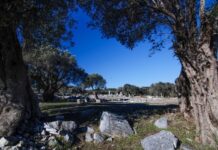We believe …life of the world to come. Amen.[The Nicene-Constantinopolitan Creed]
We detest and anathematize Arius and all the sharers of his absurd opinion; also Macedonius and those who following him are well styled “Foes of the Spirit” (Pneumatomachi). We confess that our Lady, St. Mary, is properly and truly the Mother of God, because she was the Mother after the flesh of One Person of the Holy Trinity, to wit, Christ our God, as the Council of Ephesus has already defined when it cast out of the Church the impious Nestorius with his colleagues, because he taught that there were two Persons [in Christ].
With the Fathers of this synod we confess that he who was incarnate of the immaculate Mother of God and Ever-Virgin Mary has two natures, recognizing him as perfect God and perfect man, as also the Council of Chalcedon hath promulgated, expelling from the divine Atrium [aulhs] as blasphemers, Eutyches and Dioscorus; and placing in the same category Severus, Peter and a number of others, blaspheming in divers fashions. Moreover, with these we anathematize the fables of Origen, Evagrius, and Didymus, in accordance with the decision of the Fifth Council held at Constantinople. We affirm that in Christ there be two wills and two operations according to the reality of each nature, as also the Sixth Synod, held at Constantinople, taught, casting out Sergius, Honorius, Cyrus, Pyrrhus, Macarius, and those who agree with them, and all those who are unwilling to be reverent.
Pictorial representations
To make our confession short, we keep unchanged all the ecclesiastical traditions handed down to us, whether in writing or verbally, one of which is the making of pictorial representations, agreeable to the history of the preaching of the Gospel, a tradition useful in many respects, but especially in this, that so the incarnation of the Word of God is shown forth as real and not merely phantastic, for these have mutual indications and without doubt have also mutual significations.
We, therefore, following the royal pathway and the divinely inspired authority of our Holy Fathers and the traditions of the Catholic Church (for, as we all know, the Holy Spirit indwells her), define with all certitude and accuracy that just as the figure of the precious and life-giving Cross, so also the venerable and holy images, as well in painting and mosaic as of other fit materials, should be set forth in the holy churches of God, and on the sacred vessels and on the vestments and on hangings and in pictures both in houses and by the wayside, to wit, the figure of our Lord God and Saviour Jesus Christ, of our spotless Lady, the Mother of God, of the honourable Angels, of all Saints and of all pious people.
Read More about Apologia of St John Damascene Against those who Decry Holy Images Part 36








